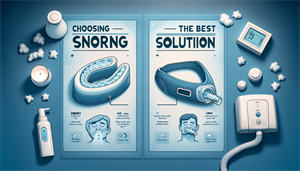
ZQuiet vs CPAP: Comparing Snoring Solutions for Effective Relief
Snoring can be an exasperating issue to tackle, especially when you're on the hunt for the perfect remedy that aligns with your lifestyle and needs. ZQuiet is dedicated to offering accurate and up-to-date information about the array of options available for snoring relief. In this exploration, let's delve into two prominent solutions: snoring mouthpieces and continuous positive airway pressure (CPAP) devices.
Understanding Snoring Mouthpieces and CPAP Devices
Snoring Mouthpieces: A Clear Path to Quiet Nights
Snoring mouthpieces, also known as "snoring mouth guards" or "oral appliances," are among the most common choices for addressing snoring. These come in two main types: mandibular advancement devices (MAD) and tongue stabilizing devices (TSD). Both variants target a core issue contributing to snoring: the relaxation of throat muscles that leads to air vibration against soft tissues, generating the distinctive sound of snoring.
Features and Benefits of Snoring Mouthpieces
Different snoring mouthpieces offer a variety of features, catering to individual preferences. Some models require preparatory steps like molding to fit your mouth, which can be uncomfortable and time-consuming. ZQuiet, however, introduces a unique approach with its Living Hinge technology and 2-Size Comfort System, allowing for an effortless and comfortable fit without the hassle of preparation.
Potential Challenges with Snoring Mouthguards
While snoring mouthpieces are effective for many, they might not be suitable for everyone. Individuals with specific dental issues such as dentures, oral prosthetics, missing teeth, or pronounced overbites might face challenges with mouthpieces. Consulting a dentist is advisable to determine if a snoring mouthpiece is compatible with your dental condition.
Introducing CPAP Devices: A Different Approach
Understanding CPAP Devices
Continuous positive airway pressure (CPAP) devices are a distinct approach to combating snoring, sleep apnea, and other breathing disorders. Unlike snoring mouthpieces, CPAP devices function by delivering a continuous stream of air pressure through a mask or nasal cannula, keeping the throat open and reducing soft-tissue vibration and snoring sounds.
Pros and Cons of CPAP Devices
While CPAP devices are known to be effective, they present unique challenges. The noise generated by the CPAP machine and the discomfort of wearing a mask can disrupt sleep. Issues like mask fitting, adjusting to air pressure, noise disturbance, claustrophobia, and falling asleep can pose obstacles. Additionally, the cost of CPAP devices might deter budget-conscious individuals.
Choosing Between an Oral Appliance and CPAP Device
Making the Decision
Ultimately, the choice between a snoring mouthpiece and a CPAP device hinges on your preferences, medical advice, and specific needs. CPAP devices excel in treating severe sleep apnea, while snoring mouthpieces provide a comfortable, cost-effective, and quick solution for general snoring. Regardless of your choice, prioritizing a restful sleep experience is crucial.


